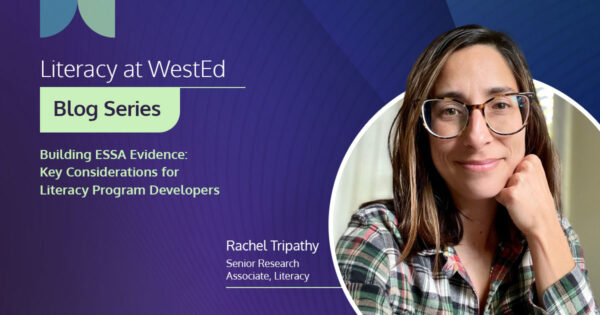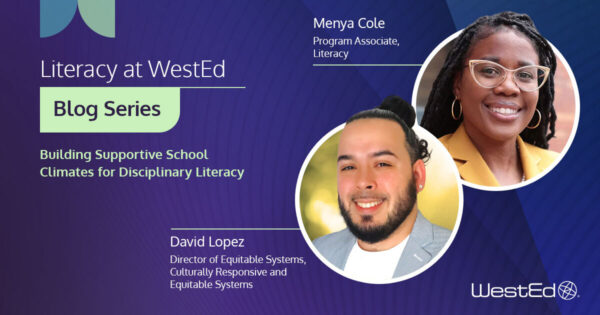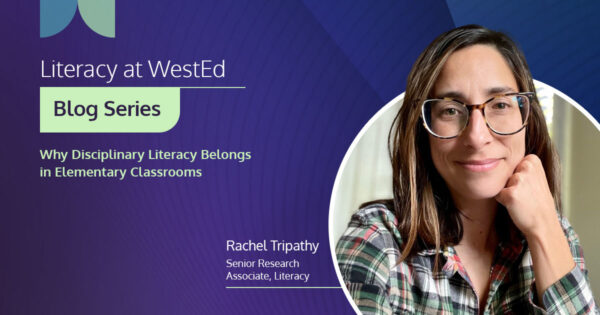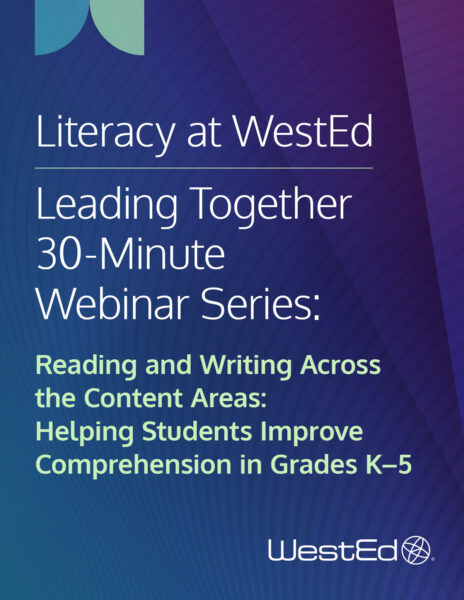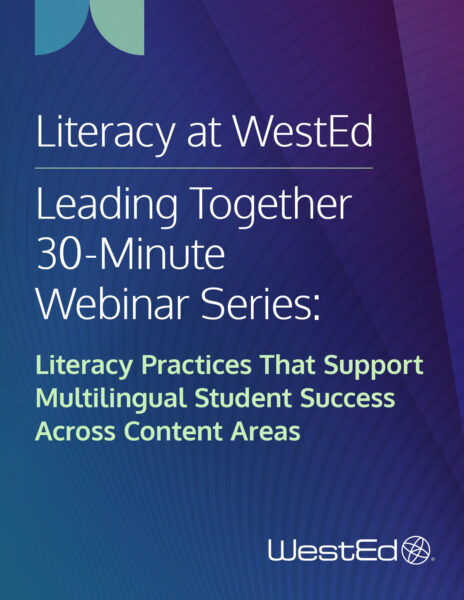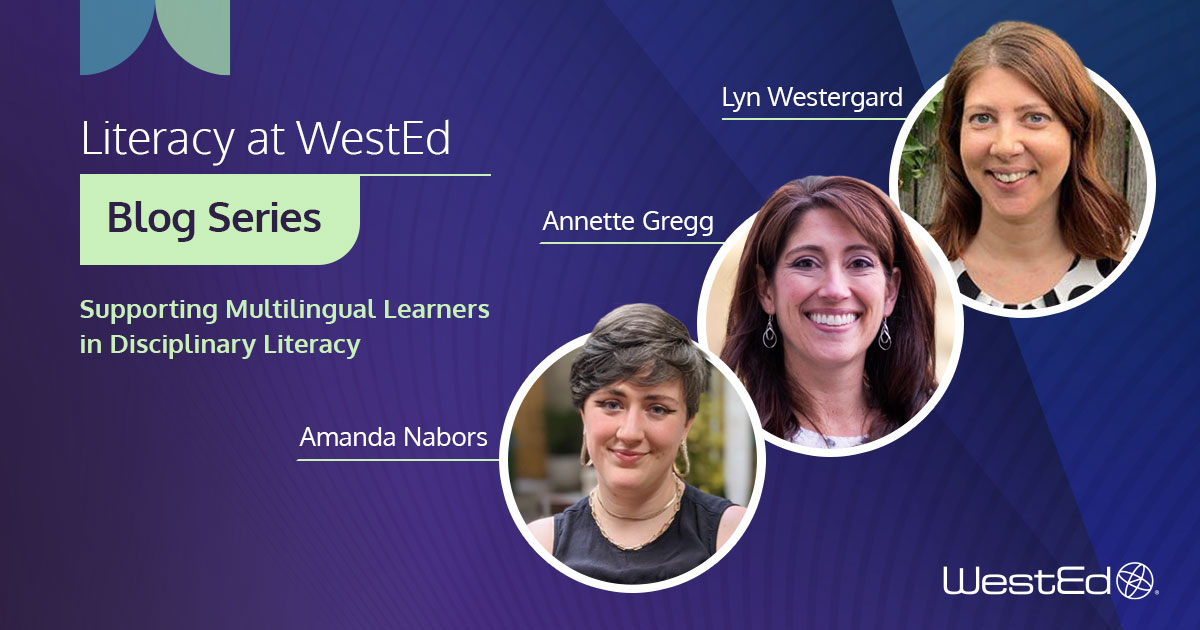
July 10, 2025
By Amanda Nabors, Annette Gregg, and Lyn Westergard
This blog series explores the concept of disciplinary literacy—the distinct ways of reading, writing, and communicating across academic fields such as science, history, math, and literature. Featuring actionable insights from WestEd thought leaders, the series looks at how integrating disciplinary literacy practices into elementary and secondary classrooms can support student success in school, in careers, and throughout their lives.
What do the following literacy practices have in common?
- students reading about and discussing a science concept in Spanish and then sharing their ideas in English
- students reading a poem in English while completing a two-column note catcher: one side documenting their thinking in English and the other side in their home language
- students studying historical images and brainstorming together using their chosen languages while taking notes in English
These are all examples of translanguaging taking place in subject area classrooms. Translanguaging is a term used to describe how multilingual individuals draw on all of their language and literacy resources to make meaning, communicate, and learn. When teachers intentionally plan and implement activities that invite and encourage students to use their full linguistic repertoire to support learning, translanguaging becomes a powerful tool for supporting Multilingual Learners across all subject areas.
In this blog post, we explore common questions educators ask about translanguaging: what it means, how it supports the development of disciplinary literacy, and how to use it strategically to support academic success for Multilingual Learners in classrooms.
García and Wei (2014) theorize translanguaging as an active process in which individuals make full use of their knowledge of multiple languages, both structurally and conceptually, to understand the world around them and to express complex ideas in one integrated language system. For example, students may brainstorm ideas in their home language before drafting in English, annotate texts in two languages, or collaborate with peers to discuss content using multiple languages.
Translanguaging isn’t code switching, in which a student might do one task entirely in one language and another task in another; translanguaging allows more fluidity and involves the integration of all of a student’s linguistic assets rather than language separation by context.
As García and Lin (2017) note, translanguaging is the norm in multilingual communication and reflects how people think, not just how they speak or write. In classrooms, translanguaging is not just something students do—it is also something teachers can intentionally plan for as part of routine instructional practices. Teachers can design opportunities for students to use their home languages as a resource to understand new content, participate in conversations across academic disciplines, and develop both home language and English proficiency over time.
As a pedagogical approach, translanguaging becomes a powerful tool for supporting Multilingual Learners and acknowledging the rich assets they bring with them to school.
Disciplinary literacy refers to the specialized practices of reading, writing, and thinking that are unique to each academic discipline, such as math or history. Scholar Elizabeth Moje (2015) presents the idea that disciplines are essentially cultures unto themselves that are socially constructed and approach the reading, analysis, and writing of different types of texts with differing methods toward differing ends.
Shanahan & Shanahan (2008) give examples of this, pointing out that scientists use evidence-based claims, historians evaluate sources for bias and context, and mathematicians communicate their reasoning through precise logic and symbols.
Content-specific skills like learning how to read a graph in science or construct a timeline in history are critical to becoming enculturated within a discipline, but a comprehensive view of disciplinary literacy goes beyond specific skill building to helping students understand, navigate, and at times belong to and critique the cultures of various disciplines through genuine participation in the discourse of that disciplinary culture (Moje, 2015).
Translanguaging offers Multilingual Learners a powerful bridge into these disciplinary cultures. Instead of students engaging with new concepts, skills, and modes of inquiry exclusively in English, translanguaging allows them to use their full linguistic resources to make sense of complex ideas and methods of knowledge production and bridge those into their working knowledge of English.
In a math class, a student might talk through the concepts of real and imaginary numbers with a peer in their home language, then practice creating number lines or solving word problems in English, interspersing their home language as needed. In a dual-language classroom, students might use both languages during a social studies exploration of maps used during the Age of Exploration, labeling the maps and writing down their thoughts in whichever language helps them communicate their thoughts most clearly.
In an English Language Arts class, a teacher might support students in annotating a text in the language of their choice and encourage students to switch between their home language and English as they discuss the feelings of the main characters.
Translanguaging allows students to use all of their linguistic assets to engage more meaningfully in the culture of a discipline, becoming more fluent in discipline-specific literacy and communication practices using all of the linguistic resources they have at their disposal. Teachers can foster these kinds of moments by designing classroom activities that encourage translanguaging within the routines of disciplinary literacy.
Even if teachers have just one Multilingual Learner in their classroom, translanguaging can still play a powerful role in fostering learning. Encouraging the student to use their home language during independent work, note-taking, or writing, as well as when they work with peers, allows them to draw upon their rich resources and knowledge and build cultural competence in the classroom more broadly.
Simple instructional practices like bilingual note-taking, inviting the student to annotate texts in their home language, and asking the student to consider how the practices and modes of knowledge production of a particular discipline are different in their country of origin or in their home language can help develop the student’s content area knowledge and understanding of a disciplinary culture.
Partnering with families is another powerful entry point. Welcoming caregivers to share stories, cultural practices, or vocabulary from home helps extend translanguaging beyond the classroom.
Teachers don’t have to speak another language to support translanguaging in their classrooms. What matters most is that teachers create a space in which all languages are valued and recognized as tools for learning and that both students and teachers immerse themselves in a discipline. Inviting students to use their home languages as they contribute to peer and class discussions helps them understand the content and practices of the discipline, as does engaging them in translingual writing practices.
For example, asking students how to say something in their home language and showing that multiple languages are welcome by including multilingual materials demonstrates that all languages are welcomed, as does prompting them to creatively engage in writing exercises that allow them to be creative with combining languages, using symbols, and otherwise expressing themselves best using a range of linguistic assets.
These small signals go a long way in building a culture of inclusion. Ultimately, translanguaging isn’t about teaching in multiple languages—it’s about making space for students to utilize their linguistic resources to support learning and development.
Multilingual speakers engage in translanguaging to make the most of their linguistic assets from early childhood—there is no need to wait for students to reach particular levels of English language development for them to engage with and benefit from oral and written translanguaging (Machado & Hartman, 2019).
In any classroom, whether teachers speak one language or many or whether there’s one Multilingual Learner or several, educators can support translanguaging by encouraging students at all levels to use all their linguistic resources to learn and make meaning. Translanguaging can be a powerful pedagogical tool to help students embrace their own linguistic resources, to engage in learning more authentically, and to support disciplinary literacy.
To learn more practical classroom strategies for supporting Multilingual Learners in the disciplines, please join us on August 7 for the 30-minute webinar Literacy Practices That Support Multilingual Student Success Across Content Areas, where we’ll explore four practices that support student language identity and skills and academic success in the disciplines.
Visit this page after August 7 to find the link to the webinar recording.
Work With Us
WestEd works to enhance literacy and improve learning for all by providing high-quality, teacher-focused professional learning, research and evaluation, and technical assistance services.
Learn how your state, district, or school can build capacity through participating in Reading Apprenticeship, Quality Teaching for English Learners institutes, and literacy research and evaluation services.
Amanda Nabors is a research associate at WestEd. She has nearly 10 years of experience in leading evaluation and research programs with a focus on early literacy, emerging Multilingual Learners, and LEA and SEA capacity building to effectively serve all learners.
Annette Gregg has extensive experience in educational leadership focused on English and Multilingual Learners. As Director of the English Learner and Migrant Education Services team, she oversees initiatives in research and professional development for educators nationwide.
Lyn Westergard served as a program associate in the Quality Teaching for English Learners initiative at WestEd. Her work on the English Learner and Migrant Education team included quantitative and qualitative educational research, program evaluation, and research design methodology.
References
García, O., & Wei, L. (2014). Translanguaging: Language, Bilingualism, and Education. Palgrave Pivot. https://doi.org/10.1057/9781137385765.
García, O., Lin, A. M., & May, S. (2017). Bilingual and Multilingual Education, Third Edition. Springer. https://doi.org/10.1007/978-3-319-02258-1.
Machado, E., & Hartman, P. (2019). Translingual writing in a linguistically diverse primary classroom. Journal of Literacy Research, 51(4), 480–503. https://doi.org/10.1177/1086296X19877462
Moje, E. B. (2015). Doing and teaching disciplinary literacy with adolescent learners: A social and cultural enterprise. Harvard Educational Review, 85(2), 254–278.
Shanahan, T., & Shanahan, C. (2008). Teaching disciplinary literacy to adolescents: Rethinking content-area literacy. Harvard Educational Review, 78(1), 40–59.
